Ed: This September, Tonie and Wade Marlow of the Blue Horse Gallery in Bellingham, shepherded 26 painters, photographers and sculptors to France. Five days in Paris, ten days at a private chateau in the countryside east of Poitiers.......yes, it was as good as it sounds. Some of the travelers were NWSSA members and two of them have witten about the trip along with Dawn Bjorn who is a painter and photographer from Bellingham.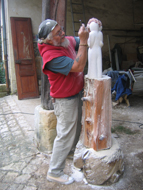
Trip Offers Rare Opportunity to Work Like Michelangelo
by Dawn M. Bjorn
Southwest of Paris near Chauvigny is a small village with a large chateau, St. Julien l’Ars, which was the gathering place for 26 Northwest artists this fall. Organized by Wade and Tony Marlow of the Blue Horse Gallery in Bellingham, our purpose was to devote some uninterrupted time to practicing our art. Of the 26, at least seven were sculptors. Others worked with a wide range of media including pen and ink, watercolor, oil and photography.
The chateau provided a wonderful and inspiring setting. Its accompanying 57 acres are filled with ancient workshops and outbuildings that provide a perfect stage for the ancient art of carving.
The chateau’s origins began in 900 A.D. But aside from the tasteful additions of modern infrastructure, little has changed since the 1700s.
Once a castle, more than once a convent or monastery, the chateau revealed a blueprint of an ancient lifestyle. It was designed not just for enjoying the good life but also for strategies of a time far different from our own, as is evidenced by its rounded turrets for archers, hidden passages for servants, and secret underground tunnels for escape.
Its architectural features reflect a merging of visual delight and ingenious utility. Centuries of cleverness went into each detail. Thick curved edges firmly seal old wood windows against rain and draughts. Beautifully scrolled, hand-hewn metal bolts lock them tight. Ten-foot windows were tall enough to flood each room with sunlight by day, and massive mirrored walls bounced candlelight by night.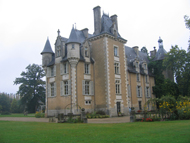
The art that was celebrated there was carved into the supporting stone structure. Inspiration is everywhere. Sensuously carved marble fireplace mantles adorned most rooms. A hand-carved limestone spiral staircase holds gnomes and demons at every turn.
A stone Virgin Mary and child gazes down from the peak of the roof. A 10-foot statue of Joan of Arc glares back across an immense space of green grass rimmed by primordial trees. Her narrow shoulders and wide hips defy classical proportions.
Often, ancient stonemasons revealed a mischievous and, I think, a suspiciously naughty side. Archways of the underground tunnel wore sconces decorated with swooping bats, rats biting their tails, and a lucky dice toss. Even the large stone acanthus-like gateposts were carved to reveal labia-like flounces at the edges. Is an Acanthus sometimes just an Acanthus?
A cobblestone path leads one from the chateau past tall trees and foraging chickens to a tall beamed stucco work shed.
There, one could hear the tap, tap, tapping of Northwest sculptors honing their craft and art. They worked in open air as sunlight bounced dramatically across surfaces, enhancing depth and texture. Here, the September air had a particular luminescence that softens shadows with an inner glow. Dusty yet beaming faces would greet us at the end of the day.
A place where time stands still is the perfect location to practice the ancient art of carving.
The Night of the Rabbit
by Nichole Sharpe
The other day while telling a friend about my trip to France, she asked me, “What was your favorite meal there?” After a moment of thought I had to chuckle, and say, The Night of the Rabbit.
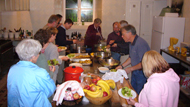
You see I love to cook. I think great things happen in the kitchen and at the table. Ideas are explored, discoveries shared, relationships developed and nurtured, and memories are made. In anticipation of this trip, knowing we would be doing some shared cooking; I pulled out a couple of my favorite recipes. The first was for Duck Confit and the other for Braised Rabbit. Once at the Château, we found no duck at our local market so the shopping group settled on rabbit. I decided to sear it and then bake it in a rich gravy (no sparing the calories on this one). We served the rabbit with red peppers, zucchini, sweet onions and yellow potatoes roasted in a little olive oil, rosemary and herb de province. We also put together a salad of pears, walnuts and soft goat cheese tossed with lettuce greens in a light orange dressing.
There was a core group of five or six doing the cooking in the kitchen. We hardly knew each other and yet there was clearly a creative buzz. At times others would wander in to help, to chat or to pore the cooks another glass of wine. Still others handled setting the big table in the dinning room. At one point I stepped back to just watch, it was clear that this group was having great fun. By the time we pulled the food out of the oven most of the 26 members of this traveling group along with Nash and Linda (the owners of the Château) had gathered in the kitchen. It was time to eat. Walking into the dinning room that evening to the sight of a twenty foot long table lighted by several candelabras and the warm glow of friends, was truly a topper.
I must admit the meal was quiet good. The salad fresh, the rabbit moist and the vegetables cooked just right.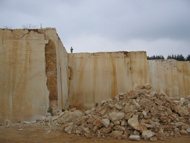
But as good as the food was the real magic was in the interaction, the sharing, the conversation – in short, the people. Great things certainly did happened in the kitchen and at the table that night and on many nights and days to follow.
The first few days home after the trip, I found myself missing the crowd in the kitchen while fixing dinner. I missed listening to the reports of what had been discovered by this person or that. I missed the buzz of people working together to create a meal. I missed the camaraderie, insights and excitement. However, long lasting memories were made, and I will take those into my work and life. With great fondness I will always remember the wonderful time we all had on The
Night of the Rabbit.
Down In The Quaries Of French Limestone
by Lloyd Whannell
My first ever trip to France this last September with my wife, Clarie, and a group of fellow stone carvers left me with some wonderful memories, some of which were the limestone quarries we visited. The beautiful chateau we stayed at, the church next door, as well as most of the older buildings and walls around us were all built with French limestone, and I would venture a guess that most of it came from the local quarries.
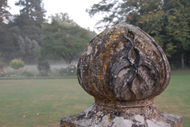
Noel, the jovial French caretaker for our château, took us to a local quarry just a few kilometers away. No one appeared to be around at this first quarry, but we gave ourselves a tour anyway. You could see the transition in the road cut down into the quarry, from dirt to broken rock with tree roots, to solid walls of limestone. The good stone being taken from the center of the quarry was a beautiful golden cream color, but the outer walls were stained an ocher rusty color, with the trees and brush growing down the edges, reclaiming the older areas. This quarry seemed to be a fairly low key operation with only a small track hoe, a loader, a belt saw on tracks, and a pile of feathers and wedges laying on a block of stone.
The second quarry Noel took us to was also close by, but they had a full production facility right there beside the quarry. Hugh blocks of limestone the size of cars were piled everywhere, and the walls of the quarry being worked were probably 30 feet tall. Their fabrication plant took the blocks and cut them to order.
Although most of the cutting was by large saws, we saw a man using an angle grinder to cut circular stair treads and watched another carving a design in one of the blocks using the familiar hammer and chisels.
We picked out some stone to carve back at the chateau after seeing the beautiful color of polished finished sculpture in their showroom. Chauvigny is the name of their stone (also the name of the nearby village) and it came in several variations. It was all a warm golden cream color, but with slightly different fineness of grain, leaving some pieces smooth and tight while others had small bubble like holes.
The third place we visited was just a fabrication facility. They brought in a similar Chauvigny stone from their local quarry, but also had other limestones from their other quarries. One of their stones was called “chateau stone” and was one of the building stones they supplied. This stone was so soft that you could carve it with a spoon when it was freshly quarried, but as it aged, it got progressively stronger, kind of like fresh concrete compared to aged concrete.
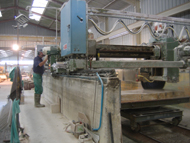
This company has limestone quarries all over France with a sales office here in the states. I am in the process of trying to find out what it would cost to bring in several varieties of their beautiful French limestone. Unfortunately no one has been eager to give me pricing, but I’ve been assured that a slow process is normal. I’ll post any results if it looks promising. If not, then I guess I’ll just have to go back and carve French limestone - IN FRANCE!!

